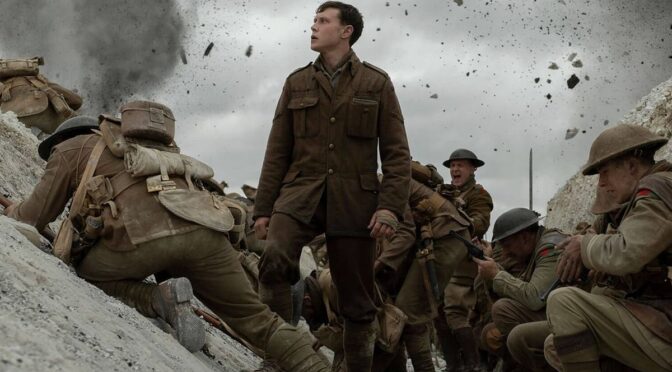An ambitious technical challenge, Sam Mendes’ 1917 has a grandeur that undoubtedly benefits from big-screen presentation. Although the story’s engagement levels can dip between set pieces, the skill of Mendes’ collaborators elevates 1917 to something a little more than the marketing hooks would imply, even if technical prowess still dominates the emotions of the characters. In particular, cinematographer Roger Deakins maximises the visual splendour of a story that is otherwise entrenched in the confusing and grubby battlefields of France in World War I.
The story follows Lance Corporal Schofield (George MacKay) and Lance Corporal Blake (Dean Charles-Chapman), as they embark upon a mission to deliver a message to another British battalion on the front in France. An assault is planned, based on the understanding that the Germans have retreated. In reality, General Erinforth (Colin Firth) knows this to be an ambush. Unless the two can reach the men – Blake’s brother amongst them – they face certain slaughter.
The hook for 1917, which awards campaigns have focused upon, is the continuous appearance of the film – a series of long takes stitched together with visual effects, to give the appearance of continuous filming. In reality, the longest is (a still impressive) 9 minutes or so. Although long takes are very much in vogue in modern filmmaking (and pops up extremely frequently in short film), this approach is 1917’s biggest strength but also introduces some aspects Mendes doesn’t necessarily overcome.
In the initial stages, as Blake and Schofield are awoken and stroll from their napping spot through fields and the trench to their commanding officer’s bunker, the way in which this continuous style is used to construct the space around them is meticulously precise. Their fellow soldiers initially fill the edges of the frame, before forming the backdrop – symbolic of the two men’s departure, perhaps – before the claustrophobic bustling of the trenches is captured. Once they embark upon their journey, the bleak, fog-filled landscapes convey a bleak and empty terror – there are endless possibilities as to what lies beyond, but the most likely fate is a bullet. The inexorable nature of the journey underscores the relentlessness of the war the men face.
“…engagement levels undoubtedly drift on a narrative level and it is questionable how much sense of an interior life you can gather from the characters of Blake and Schofield.”
There are downsides to this approach, namely that following the men continuously (bar a loss of consciousness used as a transition point) in real-time also comes with their downtime. There are elements which resemble an open-world video game but played by someone else. The engagement levels undoubtedly drift on a narrative level and it is questionable how much sense of an interior life you can gather from the characters of Blake and Schofield. The need to appear continuous restricts Mendes’ visual language: the shortcoming is a result of the stripped-back toolbox rather than Krysty Wilson-Cairns’ script, which gives ample opportunity for MacKay, in particular, to flesh his Lance Corporal Schofield out. Even then, however, there is a lack of emotional engagement which is arguably a result of the pre-eminence of the technical aspects in the film’s design and execution.
“Roger Deakins, who collaborated with Mendes to make the most visually rich Bond film ever in SKYFALL, delivers an almost impossibly good-looking film…”
However, when combined with the film’s rather more undersung technical aspects, 1917 continuously re-engages viewers. Roger Deakins, who collaborated with Mendes to make the most visually rich Bond film ever in SKYFALL, delivers a remarkably good-looking film, made all the more difficult by the variety of terrain and lighting seamlessly encountered in the story. Additionally, the score from Thomas Newman is perhaps the most valuable addition to the film’s array of talents, setting tone and pace throughout, with the crescendo of the film scored by a wonderfully soaring piece of music.
The construction of the film – even with some disengaging sequences – is designed to maximise the benefit of theatrical presentation; a saturation of sound and vision from which the film derives extra impact. 1917 is by no means a perfect film and frequently drifts away from effective storytelling in favour of technical exuberance. However, if the purpose of doing so was to create a cinematic experience then Mendes and his team undoubtedly succeed.

